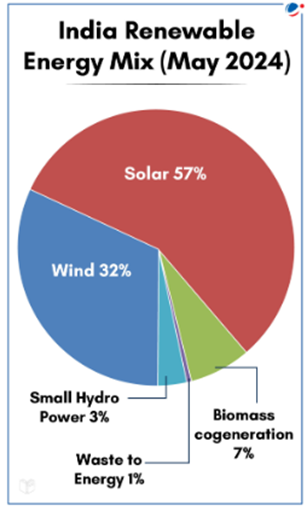Why in the News?
According to Ministry of New and Renewable Energy, India's renewable energy capacity grew by 165% in 10 years, rising from 76.38 Gigawatts (GW) in 2014 to 203.1 GW in 2024.
What is Renewable energy (RE)?

- It is energy derived from natural sources that are replenished at a higher rate than they are consumed. Renewable energy sources are plentiful and all around us.
- For Example: Solar Energy, Wind Energy, Geothermal Energy, Hydro Power, Ocean Energy, Bio Energy.
Current Status of RE in India
- The share of RE in the total installed generation capacity in the country stands at 43.12%.
- India ranks fourth globally in renewable energy capacity.
- 4th in Wind Power (46.65 GW) capacity and 5th in solar photovoltaic power (85.47 GW).
- First time crossed 200 GW capacity from non-fossil fuel sources.
- It includes Solar power: 85.47 GW, Large hydro power: 46.93 GW, Wind power: 46.66 GW, Biopower: 10.95 GW, Small hydropower: 5.00 GW, Waste to Energy: 0.60 GW.
- RE targets in India
- India aims reaching a non-fossil fuel energy capacity of 500 GW by 2030.
- Fulfilling at least half of its energy requirements via RE by 2030.

Overall Challenges faced by RE Sector in India
- High cost: The material and natural resource (primarily land) costs to generate one unit of electricity are substantially higher for RE compared to the generation of one unit of electricity from fossil fuels.
- The highly diffused nature of RE requires elaborate installations such as solar panels and wind turbines.
- Land acquisition: For e.g., Identification of land with RE potential, its conversion (if needed), clearance from land ceiling Act, decision on land lease rent, clearance from revenue department, and other such clearances take time.
- Poor DISCOMS performance: Since most DISCOMS are bound by Power Purchase Agreement (PPA) for thermal power, their capacity to procure solar based power is reduced, thus affecting the overall Renewable purchase obligations (RPO) targets.
- RPOs are mechanisms designed to compel power procurers in every state to annually purchase a certain minimum amount of renewable energy.
- Storage Concern: Due to Intermittency (Renewable sources are not constant, they fluctuate based on weather conditions) and grid balancing challenge (sudden surges or drops in renewable energy generation can strain the grid).
- Environmental: For e.g., birds and bats can have collisions with wind turbines, especially during migration seasons. Also, large amount of water is needed for hydrogen production.
Challenges in different sub-sectors of RE
Solar |
|
Wind |
|
Hydro |
|
Biomass |
|
Waste-to-Energy (WTE) |
|
Key Initiatives taken to promote Renewable Energy in India
- FDI: Up to 100% FDI is allowed under the automatic route for renewable energy generation.
- PM Surya Ghar: Muft Bijli Yojana: Aimed to install rooftop solar plants in one crore households with a total financial outlay of ₹75,021 crore and to be implemented until FY27.
- Green Energy Corridor (GEC) projects: Initiated to facilitate renewable power evacuation and reshaping of the grid for future requirements.
- Solar Parks Scheme: To provide solar power developers with a plug and play model, by facilitating necessary infrastructure along with all statutory clearances.
- National Green Hydrogen Mission, 2023: The mission targets to achieve about 5 million metric tonnes (MMT) of annual Green Hydrogen production capacity by 2030.
Way Forward
- Increase Energy Storage Capacity: Energy storage system (e.g. pump‐storage hydroelectricity, battery storage etc.) can be used for storing energy available from RE sources to be used at other times of the day.
- This can bring down the variability of generation in RE sources, improving grid stability, enabling energy/peak shifting etc.
- Centre-State Coordination: The central government needs to work with the state governments to identify exclusive land (for e.g., RE zones). Similarly, States need to ensure the 'must run' status for renewable power feeding into grid is being implemented in true spirit.
- A 'must run' status means that the concerned power plant has to supply electricity to the grid under all condition.
- Financing Innovations: Streamlining the contracting process (e.g., standardization of contracts), and making available relevant information, expanding the use of green bonds etc.
- Upgrade grid technology: System operators at all levels (i.e. state, regional and national) should have visibility of the grid status in neighbouring balancing areas and also the ability to easily coordinate with them,
- Centralized RE forecasting mechanisms need to be integrated with system operations.
- Optimise land use: Promoting the use of wasteland, marginal land, and rooftops for solar projects can reduce competition with agricultural, forest land






